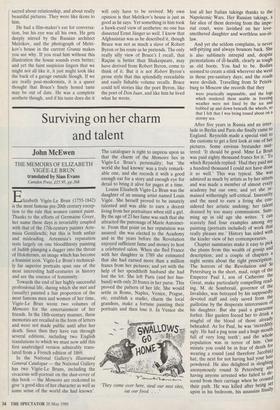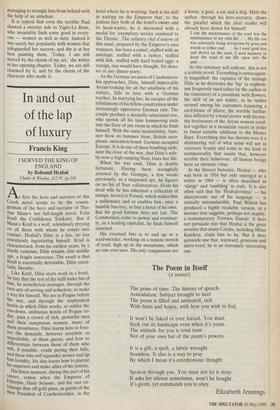Surviving on her charm and talent
John McEwen
THE MEMOIRS OF ELIZABETH VIGEE-LE BRUN translated by Sian Evans
Camden Press, £15.95, pp.368
Elizabeth Vigee-Le Brun (1755-1842) is the most famous pre-20th century excep- tion to the rule that women cannot paint. Thanks to the efforts of Germaine Greer, her name these days is invariably coupled with that of the 17th-century painter Arte- misia Gentileschi; but this is both unfair and misleading. Artemisia's reputation rests largely on one bloodthirsty painting of Judith plunging a dagger into the throat of Holofernes, an image which has become a feminist icon. Vigee-Le Brun's technical- ly far superior portraits span one of the most interesting half-centuries in history and are the essence of femininity.
Towards the end of her highly successful professional life, during which she met and (usually) painted a fair proportion of the most famous men and women of her time, Vigte-Le Brun wrote two volumes of Memoirs for the entertainment of her friends. In the 18th-century manner, these memories are recalled in the form of letters and were not made public until after her death. Since then they have run through several editions, including two English translations to which we must now add this first unabridged version admirably trans- lated from a French edition of 1869.
In the National Gallery's Illustrated General Catalogue — the National Gallery has two Vigee-Le Bruns, including the vivacious self-portrait on the dust-cover of this book — the Memoirs are reckoned to give 'a good idea of her character as well as some sense of the world she had known'. The cataloguer is right to impress upon us that the charm of the Memoirs lies in Vigee-Le Brun's personality; but 'the world she had known' was a truly remark- able one, and she records it with a good enough ear for a story and enough eye for detail to bring it alive for pages at a time.
Louise Elisabeth Vigee-Le Brun was the daughter of an unsung artist named Louis Vigee. She herself proved to be innately talented and was able to earn a decent living from her portraiture when still a girl. By the age of 23 her fame was such that she attracted the patronage of Marie Antoinet- te. From that point on her reputation was assured: she was elected to the Academy and in the years before the Revolution enjoyed sufficient fame and money to host a celebrated salon. When she fled France with her daughter in 1789 she estimated that she had earned more than a million francs from her pictures; and yet with the help of her spendthrift husband she had lost the lot. She left Paris (and her hus- band) with only 20 francs in her purse. This proved the pattern of her life. She would settle in Rome, Naples, Venice, Prague, etc, establish a studio, charm the local grandees, make a fortune painting their portraits and then lose it. In Venice she 'They come over here, steal our nest sites, eat our food . . lost all her Italian takings thanks to the Napoleonic Wars. Her Russian takings, a fair slice of them deriving from the impe- rial court, were lavished on her love- smothered daughter and worthless son-in- law.
And yet she seldom complains, is never self-pitying and always bounces back. She is also sublimely intrepid and, despite protestations of ill-health, clearly as tough as old boots. You had to be. Bodies seemed to create a stink wherever she went in those pre-sanitary days; and the roads were devilish. Travelling from St Peters- burg to Moscow she records that they
were practically impassable, and the logs which rendered them usable in freezing weather were not fixed by the ice and bobbed up and down beneath the wheels, so that I felt that I was being tossed about on a stormy sea.
After five years in Russia and an inter- lude in Berlin and Paris she finally came to England. Reynolds made a special visit to the customs to get a first look at one of her pictures. Some envious bystander mut- tered: 'It should be good. Mme Le Brun was paid eighty thousand francs for it.' To which Reynolds replied: 'Had they paid me a hundred thousand I could not have done it so well.' This was typical. She was admired as much by artists as by her sitters and was made a member of almost every academy but our own; and yet she re- mained witheringly self-critical. Insecurity and the need to earn a living she con- sidered her artistic undoing; her talent drained by too many commissions. Sum-
ming up in old age she writes: can scarcely find four examples among my painting (portraits included) of work that really pleases me.' History has sided with the kinder view of her contemporaries.
Chapter summaries make it easy to pick the plums from this wealth of gossip and description; and a couple of chapters a night seems about the right prescription. The horrors of the Revolution and St Petersburg in the short, mad, reign of the Emperor Paul I, son of Catherine the Great, make particularly compelling read- ing. M. de Sombreuil, governor of the Invalides, was betrayed by his supposedly devoted staff and only saved from the guillotine by the desperate intercession of his daughter. But she paid a gruesome forfeit. Her gaolers forced her to drink a mugful of the blood of those already beheaded. As for Paul, he was 'incredibly ugly. He had a pug nose and a huge mouth full of very long teeth'; and the whole population was in terror of him. One minute you could be in fear of death for wearing a round (and therefore Jacobin) hat; the next for not having had your hair powdered. He also delighted in sleighing anonymously round St Petersburg and having anyone arrested who failed to de- scend from their carriage when he crossed their path. He was killed after being set upon in his bedroom, his assassins finally managing to strangle him from behind with the help of an armchair.
It is typical that even the terrible Paul showed a sweeter side to Vigee-Le Brun, who invariably finds some good in every- one — women as well as men. Indeed it was surely her popularity with women that safeguarded her success; and she is at her best painting them. 'Today, I am still moved by the charm of my art,' she writes in her opening chapter. Today, we are still charmed by it; and by the charm of the character who made it.



































































 Previous page
Previous page